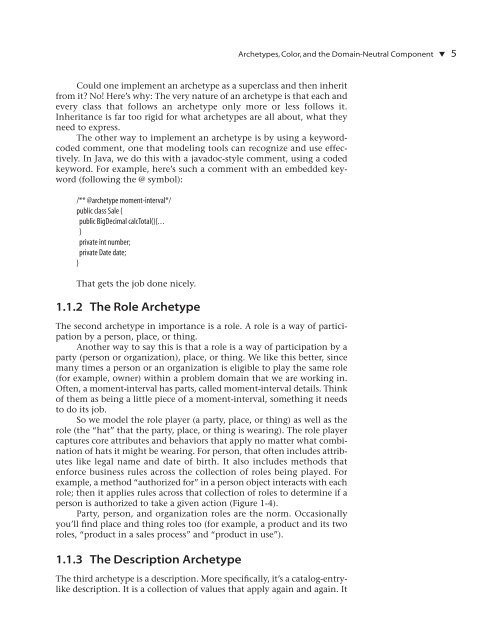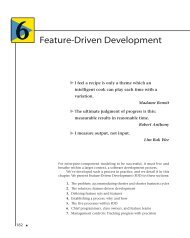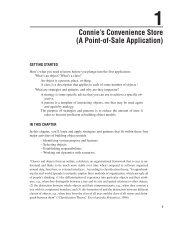Archetypes, Color, and the Domain-Neutral ... - Petercoad.com
Archetypes, Color, and the Domain-Neutral ... - Petercoad.com
Archetypes, Color, and the Domain-Neutral ... - Petercoad.com
You also want an ePaper? Increase the reach of your titles
YUMPU automatically turns print PDFs into web optimized ePapers that Google loves.
<strong>Archetypes</strong>, <strong>Color</strong>, <strong>and</strong> <strong>the</strong> <strong>Domain</strong>-<strong>Neutral</strong> Component ▼ 5Could one implement an archetype as a superclass <strong>and</strong> <strong>the</strong>n inheritfrom it? No! Here’s why: The very nature of an archetype is that each <strong>and</strong>every class that follows an archetype only more or less follows it.Inheritance is far too rigid for what archetypes are all about, what <strong>the</strong>yneed to express.The o<strong>the</strong>r way to implement an archetype is by using a keywordcoded<strong>com</strong>ment, one that modeling tools can recognize <strong>and</strong> use effectively.In Java, we do this with a javadoc-style <strong>com</strong>ment, using a codedkeyword. For example, here’s such a <strong>com</strong>ment with an embedded keyword(following <strong>the</strong> @ symbol):/** @archetype moment-interval*/public class Sale {public BigDecimal calcTotal(){. . .}private int number;private Date date;}That gets <strong>the</strong> job done nicely.1.1.2 The Role ArchetypeThe second archetype in importance is a role. A role is a way of participationby a person, place, or thing.Ano<strong>the</strong>r way to say this is that a role is a way of participation by aparty (person or organization), place, or thing. We like this better, sincemany times a person or an organization is eligible to play <strong>the</strong> same role(for example, owner) within a problem domain that we are working in.Often, a moment-interval has parts, called moment-interval details. Thinkof <strong>the</strong>m as being a little piece of a moment-interval, something it needsto do its job.So we model <strong>the</strong> role player (a party, place, or thing) as well as <strong>the</strong>role (<strong>the</strong> “hat” that <strong>the</strong> party, place, or thing is wearing). The role playercaptures core attributes <strong>and</strong> behaviors that apply no matter what <strong>com</strong>binationof hats it might be wearing. For person, that often includes attributeslike legal name <strong>and</strong> date of birth. It also includes methods thatenforce business rules across <strong>the</strong> collection of roles being played. Forexample, a method “authorized for” in a person object interacts with eachrole; <strong>the</strong>n it applies rules across that collection of roles to determine if aperson is authorized to take a given action (Figure 1-4).Party, person, <strong>and</strong> organization roles are <strong>the</strong> norm. Occasionallyyou’ll find place <strong>and</strong> thing roles too (for example, a product <strong>and</strong> its tworoles, “product in a sales process” <strong>and</strong> “product in use”).1.1.3 The Description ArchetypeThe third archetype is a description. More specifically, it’s a catalog-entrylikedescription. It is a collection of values that apply again <strong>and</strong> again. It




